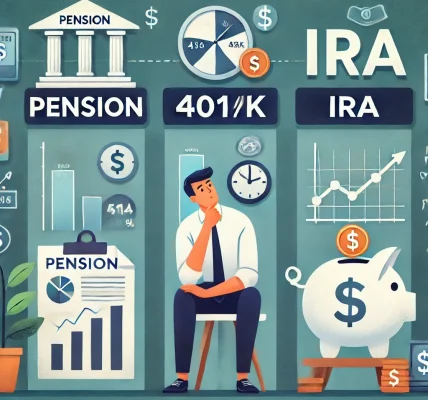Planning for retirement is not just about saving money—it’s also about optimizing your savings through tax-efficient strategies. Understanding the tax benefits of various retirement plans can help you maximize your wealth and reduce your overall tax burden. This guide will provide a comprehensive overview of different retirement plans and their tax advantages, ensuring you make informed financial decisions.
Why Tax Benefits Matter in Retirement Planning
Tax benefits play a crucial role in retirement savings by:
- Reducing taxable income during working years.
- Allowing tax-deferred or tax-free growth of investments.
- Minimizing tax liability during retirement withdrawals.
- Offering potential deductions and credits to enhance savings.
With various retirement savings options available, choosing the right plan based on tax advantages is essential for long-term financial security.
Types of Retirement Plans and Their Tax Benefits
1. Traditional IRA (Individual Retirement Account)
A Traditional IRA allows individuals to contribute pre-tax income, lowering taxable income for the contribution year. Investments grow tax-deferred, and withdrawals are taxed as ordinary income in retirement.
Tax Benefits:
- Contributions may be tax-deductible, reducing taxable income.
- Tax-deferred growth on investments.
- No capital gains tax on investment earnings.
Considerations:
- Withdrawals before age 59½ are subject to a 10% early withdrawal penalty (with some exceptions).
- Required Minimum Distributions (RMDs) begin at age 73.
2. Roth IRA
Unlike a Traditional IRA, contributions to a Roth IRA are made with after-tax dollars, but withdrawals in retirement are tax-free, including investment earnings.
Tax Benefits:
- Tax-free growth and withdrawals in retirement.
- No RMDs, allowing continued tax-free investment growth.
- Contributions (not earnings) can be withdrawn tax- and penalty-free anytime.
Considerations:
- No tax deduction on contributions.
- Income limits restrict eligibility for high earners.
3. 401(k) and 403(b) Plans
Employer-sponsored retirement plans like 401(k) (for private sector employees) and 403(b) (for public sector and nonprofit employees) allow tax-deferred contributions.
Tax Benefits:
- Contributions are made pre-tax, reducing current taxable income.
- Tax-deferred investment growth until withdrawals.
- Employers often offer matching contributions, essentially providing free money.
Considerations:
- Early withdrawals before age 59½ may incur a 10% penalty.
- RMDs begin at age 73.
- Contribution limits are higher than IRAs, allowing greater tax-deferred savings.
4. Roth 401(k) and Roth 403(b)
These employer-sponsored plans combine features of a traditional 401(k) and a Roth IRA, allowing after-tax contributions with tax-free withdrawals.
Tax Benefits:
- Tax-free growth and withdrawals in retirement.
- No income limits for contributions.
- Employer matching contributions go into a traditional 401(k) account, still benefiting from tax deferral.
Considerations:
- No immediate tax deduction on contributions.
- RMDs are required unless funds are rolled into a Roth IRA.
5. SIMPLE IRA (Savings Incentive Match Plan for Employees)
A SIMPLE IRA is designed for small businesses and allows both employer and employee contributions.
Tax Benefits:
- Contributions are tax-deductible, reducing taxable income.
- Tax-deferred investment growth.
- Employer contributions are mandatory, boosting savings.
Considerations:
- Lower contribution limits compared to a 401(k).
- Early withdrawals within two years of account opening incur a 25% penalty.
6. SEP IRA (Simplified Employee Pension IRA)
A SEP IRA is ideal for self-employed individuals and small business owners, allowing higher contribution limits than traditional IRAs.
Tax Benefits:
- Employer contributions are tax-deductible.
- Tax-deferred investment growth.
- Flexible contribution amounts based on business profits.
Considerations:
- Only employers contribute (employees cannot make their own contributions).
- RMDs apply starting at age 73.
7. Health Savings Account (HSA) – A Hidden Retirement Tool
While primarily used for medical expenses, an HSA can function as a tax-advantaged retirement savings vehicle.
Tax Benefits:
- Contributions are tax-deductible.
- Investments grow tax-free.
- Withdrawals for qualified medical expenses are tax-free.
- After age 65, withdrawals for non-medical expenses are penalty-free (though taxed as income).
Considerations:
- Requires a high-deductible health plan (HDHP) to qualify.
- Contribution limits are lower compared to retirement plans.
Tax Strategies for Maximizing Retirement Savings
1. Diversify Tax Treatments
A mix of tax-deferred (Traditional IRA, 401(k)) and tax-free (Roth IRA, Roth 401(k)) accounts provides flexibility in managing tax liabilities in retirement.
2. Take Advantage of Employer Matching
Maximize employer contributions in a 401(k) or SIMPLE IRA to get the full benefit of free money and tax-deferred growth.
3. Consider Roth Conversions
Converting traditional retirement funds into a Roth IRA during low-income years can reduce long-term tax liabilities and allow tax-free withdrawals later.
4. Delay Social Security Benefits
Deferring Social Security benefits until age 70 increases monthly payouts and can reduce taxable income in early retirement years.
5. Utilize Tax-Loss Harvesting
Offset investment gains with losses in taxable brokerage accounts to reduce overall tax burdens.
Final Thoughts
Understanding the tax benefits of different retirement plans is key to building a tax-efficient retirement strategy. Whether you’re a low-income earner looking for tax deductions or a high-income earner seeking tax-free growth, there’s a retirement plan that fits your needs. By strategically combining tax-deferred and tax-free accounts, taking advantage of employer contributions, and optimizing withdrawal strategies, you can maximize your retirement savings while minimizing tax burdens.




